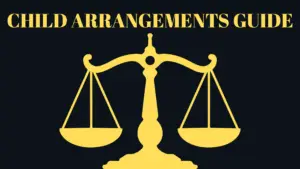A Father’s Complete Guide to Child Arrangements Orders (CAO): From Application to Enforcement
“Last Updated” Date: Saturday, 18 October 2025
When you’re fighting for time with your child, the moment your world turns upside down, it can feel like you are being put through an impossible emotional wringer. Many fathers I speak to feel lost, angry, and confused by a system that seems stacked against them. You may feel that ‘you have been subjected to significant emotional discomfort’ just trying to be a dad.
This guide is your single source of truth. It’s a clear, strategic map of the entire Child Arrangements Order (CAO) process, from the first form to the final hearing and beyond. We will cover what a CAO is, how to apply, what Cafcass and the court actually do, and your options if the order is broken. This is your plan.
Key Takeaways
- What a CAO is: A Child Arrangements Order (CAO) is a court order that defines who a child lives with (“lives with”) and who they spend time with (“spends time with”), replacing the old “residence” and “contact” orders.
- The First Step is MIAM: Before you can apply to court, you are legally required to attend a Mediation Information and Assessment Meeting (MIAM), unless an exemption (like domestic abuse) applies.
- Application is Form C100: The application to start the process is Form C100. If you are making allegations of harm, you must also use Form C1A.
- Cafcass is Involved Immediately: Once you apply, Cafcass (or CAFCASS Cymru) will conduct safeguarding checks and a telephone interview with you before your first hearing.
- Vary vs. Enforce: If circumstances change, you apply to vary the order (using Form C100). If the order is being broken, you apply to enforce it (using Form C79).
Want one-to-one guidance on this? Message us now on WhatsApp.
Jump To
- A Deep Dive: What is a Child Arrangements Order?
- Your Strategic Path: How to Get a CAO (The 5-Step Process)
- Inside the Court: The Hearing Process Explained
- At a Glance: Application (C100) vs. Enforcement (C79)
- When Life Changes: Varying Your Child Arrangements Order
- Holding to Account: Enforcing Your Child Arrangements Order
- FAQs about Child Arrangements Orders
🧠 Insider Insight: As a former Cafcass and Children’s Services Social Worker, I can tell you that your case begins the moment you apply. That first safeguarding call from Cafcass is not a casual chat. It is an assessment. What you say, the concerns you raise (and how you raise them), and your focus on your child will be written in a safeguarding letter that the judge reads before they ever see you. Preparation for this call is non-negotiable. Learn more about Lach’s background.
A Deep Dive: What is a Child Arrangements Order?
Child Arrangements Order (CAO)
A Child Arrangements Order (CAO) is a legally binding order made by the Family Court in England and Wales. It is defined under Section 8 of the Children Act 1989. This single order, introduced by the Children and Families Act 2014, replaced the old, separate “Residence Orders” and “Contact Orders.”
What This Means For You: The court no longer grants “custody” or “access.” Instead, a CAO will state:
- “Lives With”: This specifies the person with whom the child will live. An order can name two or more people (a “shared lives with” order).
- “Spends Time With” or “Contact”: This specifies when the child will spend time or have other contact (like phone or video calls) with the person they do not live with.
This change in terminology was deliberate, designed to move parents away from a “winner-takes-all” mentality and focus them on the child’s needs and their co-parenting relationship.
Your Strategic Path: How to Get a CAO (The 5-Step Process)
Here is the step-by-step process for applying for a Child Arrangements Order.
- Step 1: Attempt Non-Court Dispute Resolution (NCDR)
Before you can file an application, the law requires you to first try to resolve your dispute outside of court. This means you must contact a mediator and attend a Mediation Information and Assessment Meeting (MIAM). A mediator will explain your options. The court will not accept your application without a form signed by a mediator, unless you have a valid exemption (e.g., you have been a victim of domestic abuse, or the case is extremely urgent). - Step 2: Complete the Application (Form C100)
If mediation is unsuitable or fails, you apply to the court using Form C100.- Form C1A: If you or your child have suffered or are at risk of harm (e.g., domestic violence, abuse), you must complete this supplemental form.
- Form C8: If you need to keep your address or contact details confidential from the other party, you must file this form.
- Court Fee: You must pay the court fee (currently £263) or apply for a fee exemption (Form EX160).
- Step 3: Cafcass Safeguarding Checks
As soon as the court accepts your application, it notifies Cafcass (Children and Family Court Advisory and Support Service). A Cafcass officer (also called a Family Court Adviser) will:- Run safeguarding checks with the police and local authority.
- Call you for a telephone interview to discuss your application and any welfare concerns.
- Call the other parent (the respondent) for their side.
- Write a short “Safeguarding Letter” to the court summarising these checks and any risks.
- Step 4: Serve the Application
The court will send a copy of your application and the date of the first hearing to the other parent (respondent). You will also receive a copy. - Step 5: Prepare for the First Hearing (FHDRA)
This is the first court date. You will likely be asked to write a “Position Statement” summarising your case and what you are asking for.
Inside the Court: The Hearing Process Explained
The court process can be long and confusing. Here are the key hearings you need to know about.
1. First Hearing Dispute Resolution Appointment (FHDRA)
This is the first hearing, usually 4-6 weeks after you apply. A Cafcass officer will be present with the judge or magistrates. The goals of this hearing are:
- To see if an agreement can be reached between you. If you agree, the court can make a “Consent Order,” and the process ends.
- If you can’t agree, the court will identify the issues in dispute.
- The court will then give “directions,” which are instructions for what happens next. This might include ordering a Section 7 Report from Cafcass, ordering drug/alcohol tests, or setting dates for statements to be filed.
Learn more about what to expect at your first hearing.
2. Finding of Fact Hearing (if necessary)
If there are serious, disputed allegations of domestic abuse or harm that the court thinks are relevant to the final decision, a separate hearing may be held. The judge will hear evidence only on these allegations to decide what is “more likely than not” to have happened. This finding then informs the final welfare decision.
3. Dispute Resolution Appointment (DRA)
This is often the “second” hearing, held after reports (like a Section 7 report) have been filed. It is another chance for the judge to help you and the other parent reach an agreement or at least narrow the issues. If you still can’t agree, the judge will set the case for a Final Hearing.
4. Final Hearing
This is the last resort. If no agreement can be reached, a judge will hear oral evidence from you, the other parent, and any experts (like the Cafcass officer). You will be cross-examined. The judge will then make a final, binding decision based on what is best for your child, using the Welfare Checklist as their guide.
At a Glance: Application (C100) vs. Enforcement (C79)
This is one of the most common and costly mistakes: using the wrong form. Here’s how to know which one you need.
| Feature | Application (Form C100) | Enforcement (Form C79) |
|---|---|---|
| Goal | ✅ To get a new order, or change (vary) an existing one. | ❌ To make someone follow an existing order they are breaking. |
| When to Use It | You have no order and need one. OR Your life/child’s life has changed, and the old order no longer works. | Your ex has an order but is willfully ignoring it (e.g., stopping contact without a good reason). |
| Example | “My old order is for every other weekend, but my child now does weekend sports, so I want to change my time to midweek.” | “My order says I have my child every Saturday, and my ex has refused to hand them over for the last three weeks.” |
| Legal Test | The child’s welfare (Welfare Checklist). | Whether the order was broken “without a reasonable excuse” (on the balance of probabilities). |
| Outcome | ✅ A new or varied Child Arrangements Order. | ✅ Sanctions (unpaid work, fines) or a change of residence (rarely). The goal is to get the order back on track. |
Avoid costly mistakes — chat with us today and get practical, fixed-fee support.
When Life Changes: Varying Your Child Arrangements Order
An order is not set in stone forever. If circumstances change significantly, you can apply to vary (change) the order. Common reasons to vary a CAO include:
- A new job with different hours.
- Relocating to a new area.
- Your child’s wishes and feelings (especially as they get older).
- New commitments for the child (e.g., starting secondary school, new long-term clubs).
- Concerns about the child’s wellbeing under the current arrangement.
The process to vary an order is the same as the initial application: you must attend a MIAM and then apply using Form C100, outlining the change in circumstances.
Holding to Account: Enforcing Your Child Arrangements Order
A breach of a Child Arrangements Order is a serious matter. If the other parent is not complying with the order and has no reasonable excuse, you can apply for enforcement.
You must use Form C79 to start the enforcement process. The court will take a holistic view (Section 11J of the Children Act 1989) and must find that the breach occurred without a reasonable excuse.
Available sanctions include:
- Unpaid Work Requirement (UWR): 40-200 hours of unpaid work.
- Financial Compensation: For proven financial loss (e.g., wasted travel).
- Fines or Imprisonment: For contempt of court (extremely rare).
- Transfer of Residence: In the most extreme cases of persistent, unjustified non-compliance (implacable hostility or parental alienation), the court can, as a last resort, order the child to live with the other parent.
The court’s primary goal is not to punish, but to reinstate the order and support the child’s relationship with both parents. Find out more about handling breaches here.
FAQs about Child Arrangements Orders
Here are answers to the most common questions fathers ask about the CAO process.
What is the difference between “custody” and a “Child Arrangements Order”?
“Custody” is an old, outdated term that is no longer used by the courts in England and Wales. The modern equivalent is a Child Arrangements Order (CAO). This order does not grant one parent “custody” but instead outlines the practical arrangements for the child’s care, specifying who the child “lives with” and “spends time with.” The focus is on parental cooperation, not one parent winning over the other.
What happens if my ex breaks the Child Arrangements Order?
If your ex-partner breaks the order (e.g., stops you from seeing your child) without a reasonable excuse (like the child being genuinely sick), this is a breach. You should not retaliate. Your formal remedy is to apply to the court for an enforcement order using Form C79. The court can then impose sanctions, such as unpaid work or a fine, to ensure compliance. If your ex won’t let you see your child, read our detailed guide.
How much does it cost to get a Child Arrangements Order?
To start a new application for a Child Arrangements Order (using Form C100), the court filing fee is currently £263. This fee is set by HM Courts & Tribunals Service. If you are on a low income or certain benefits, you may be eligible for a fee reduction or exemption by completing Form EX160.
Get the Expert Support You Need to Navigate the System
At Dads Consultancy, we provide the specialised, expert support to move you from crisis to control. We can help you with:
- Making Your Application (C100)
- Handling the CAFCASS Call
- Navigating Child Arrangements Orders
- McKenzie Friend Support
- MIAM/Mediation Guidance
- Responding to Non-Molestation Orders
- Drafting Powerful Position Statements
- Navigating Section 7 Reports
This process is complex, but it is manageable with the right strategy. You do not have to walk into court unprepared. We offer fixed-fee support to guide you through every single step, from drafting a C100 that gets taken seriously to preparing you for your Final Hearing. Contact us today and let’s build your case.
🧠 Insider Insight: Lach, our founder, is a former Cafcass and Children’s Services Social Worker. He has been on the inside of the family court system, writing the very reports that influence court outcomes. Now he uses that insider knowledge to help dads navigate the process effectively. Learn more about Lach’s background.




